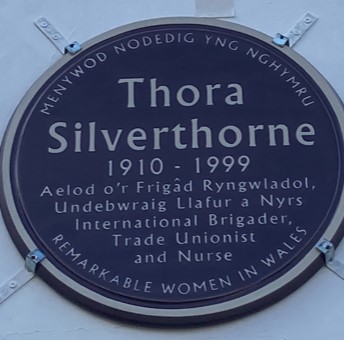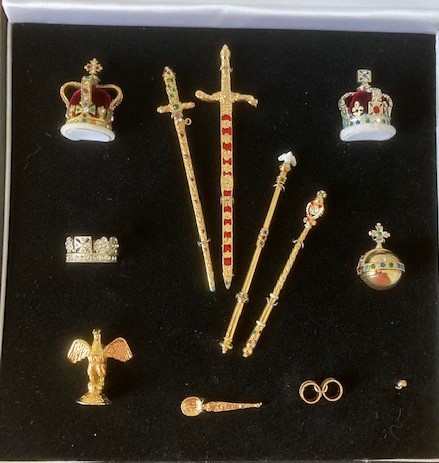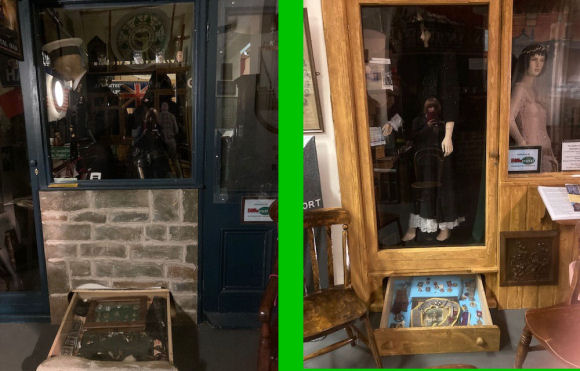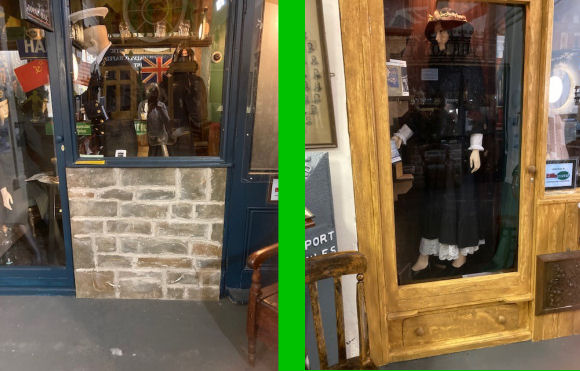Dates for your Diary
Throughout June – Platinum Jubilee Exhibition
Thurs 2nd & Sat 4th June - Treasure Hunt
Saturday 25th June 2022 - Aberfest 10am - 4pm
Museum opening times
The Museum is open to the public, free of charge:
Thursday* to Saturday 10am – 1pm
May 100 Club
This month’s prize numbers were drawn by museum member Gillian Yemm and one lucky winner scooped both prizes!
No. 48 Colin Ewers £20
No. 84 Colin Ewers £10
If you would like to join our 100 club and be in with a chance of winning, it costs just £1 a month. Ask at the museum for further details.
Cost of Living
Due to the cost of living crisis, we regret to announce a small increase in some of our café prices and the end to free biscuits with our hot drinks however packets of biscuits are available to buy for just 25p (more hygienic and prefect for sharing!).
Purple Plaque

 The plaque to honour Thora Silverthorn went ahead as planned on Friday 13th May. Normally such plaques are cemented in place however, due to work that needs to be done to the museum building, on this occasion it had to screwed to the wall. The plaque itself was unveiled by Thora’s daughter and great-grandchildren. To see the actual moment of the unveiling, head on over to the museum’s Facebook page.
The plaque to honour Thora Silverthorn went ahead as planned on Friday 13th May. Normally such plaques are cemented in place however, due to work that needs to be done to the museum building, on this occasion it had to screwed to the wall. The plaque itself was unveiled by Thora’s daughter and great-grandchildren. To see the actual moment of the unveiling, head on over to the museum’s Facebook page.
Platinum Jubilee Exhibition

As part of our Platinum Jubilee exhibition we have managed to obtain on loan nothing less than the Crown Jewels (well a very cute miniature version at least!).
The exhibition will run throughout June so do pop in and take a look.
Platinum Food Trail
After picking up a free magazine from one of the supermarkets I saw an article on the food changes through the reign of our Queen and it made me think of how my food choices have increased and changed over my life time. I have been told many times by my parents that rationing was still about in early 1950’s but as I didn’t arrive until 1961 I am thankful that I didn’t know anything about that.
Being brought up in a Welsh valley the trends would not reach us until a good while after the main cities and towns around England and maybe into Wales and our favourite would have been fish and chip supper and the good old Sunday roast! The 1960’s menu in my home was a lot of home cooked meals brought with fresh ingredients from the local shops, and it wasn’t until I was around 11 years of age that I ever went to a supermarket! When my mother had a brand new fridge in the kitchen with the tiny little freezer section I discovered fish fingers!
I went from the dreaded school dinners at primary school to junior comprehensive at Gelli Crug and the trip to the town chippy for lunch! By the time I had left school and started to work the big birthdays came along and my parents took me to Newport to the New Moon Chinese restaurant for my treat – I had chicken Maryland and it was divine! I moved jobs and upped my taste in foods – the choice at BT Cwmcarn staff canteen was wonderful and the big excitement of the week was Friday...cheesy beans on toast!! Also at this time I started to go ‘out’ drinking and was taken to my first Indian restaurant – the Lahore in Newport and I must admit I was not very impressed at all! Ha! My friends and I would also go out to Risca and Blackwood for special occasion meals where prawn cocktail, chicken chasseur, steak Dianne and of course gateau was discovered!
By the time I got married in the 80’s all kitchens had fridge freezers – thank heavens!! Even though I loved food I had no real idea how to cook so frozen and tinned foods were brilliant! My friend told me how to make spaghetti Bolognese but forgot to tell me to add meat...for weeks we ate it without! Along came children and McDonalds! The takeaways had taken over...Chinese, Indian and even Italian foods were here to stay and are still with us today plus a whole lot more! As we turned the decade eating out was just the ‘norm’ and garlic, chilli, herbs & spices plus coffee shops was nothing unusual. Who would have thought when I was a child that eating raw fish would be the ‘in’ thing, or being a vegetarian or vegan.....imagine giving your grandmother humus or tofu!!
As world of travel has opened up so has our taste buds and we are so lucky to have the choices but just try and remember to not waste food if possible, not everyone in the world is as lucky as we are.
All these foods are now classed as everyday things but back in the day grandma would have had a fit....
Karen Pratley
Hidden Treasures
Having been involved with the museum for some years now, I thought I had had seen all the exhibits however I was mistaken. I am referring to two hidden drawers within the chapel/pub area…

Above you see them, and below you don’t!

The chapel drawer contains items relating to the Freemasons while the pub drawer contains items such as a pair of police handcuffs and truncheon plus lots of military cap badges. It is not possible to leave the drawers open but next time you are in, please ask to see them and we will oblige!
THE TIPTON EXPLOSION
We tend to think only of men when we read of explosions but the explosion at Tipton, near Birmingham, one hundred years ago in March 1922, killed only women. Well, girls really.
The need for munitions in the First World War led to the setting up of many munitions factories. However, perhaps inevitably, when that terrible war ended there was a huge stockpile of ammunition requiring to be dismantled and made safe. It was a potentially attractive proposition from a financial point of view as there was money to be made from the recovered copper and lead. It was also highly dangerous. The business of dismantling ammunition was highly regulated and those involved in this trade needed to be licensed and provide suitable training, clothing and premises. As ever, sometimes the rules are not strictly followed and the results can be disastrous. That was certainly the case in this instance.
To cut a long story short, the original purchasers of the ammunition in question were properly licensed and operated under the necessary safety conditions. The girls who worked there were provided with pads for their shoes to prevent sparks, there were fireproof screens in place, and they were paid between £3 - £4 per week. Some of the stock was sold on but to an unscrupulous company who lied about having the necessary licence and familiarity with health and safety procedures. The premises in question comprised a small foundry with a concrete floor, an old stove in the middle, no extraction fans or suitable ventilation. To maximise their profits the operators of the business employed girls aged between 13 and 16 and paid them the pitiful sum of between 2s 4d and 3s 4d - this was for a week's work. Up to 30 girls could be working at the site, in a room measuring just 30 feet by 27 feet. Although there was an obvious danger from the use of the stove given the amount of explosive dust which inevitably settled on the floor, those concerns were ignored.
The inevitable happened on Monday 6th March 1922; it was a bitterly cold day and so the fire in the stove was well stoked while the girls worked at emptying the cartridges, tipping the explosive into open boxes ready for emptying into the neighbouring canal at the end of the day. A spark from the stove, or possibly from one of the girls' hob nailed boots, caused a devastating explosion. The injuries were terrible. Within twelve hours of the explosion, twelve of the girls had died. Within a week another seven died and the survivors suffered serious and debilitating burns.
Questions were asked in Parliament and a trial was held. Those involved were prosecuted and the original company was criticised for not having exercised due diligence in handing on some of their stock. Some of those involved were imprisoned and orders were made for compensation to be paid to the girls and their families. In truth, not all the compensation was paid and no-one was sure just how many girls had been at the site that day. What was known was that 19 young girls were killed and many more badly injured and disfigured. There is a memorial in Tipton Cemetery to the girls who died.
Jen Price
Spaghetti Junction
Spaghetti Junction, or to give it its formal name of Gravelly Hill Interchange, has just had its 50th birthday. The interchange at junction 6 of the M6 acquired its name thanks to journalist Roy Smith from the Birmingham Evening Mail, who on 1st June 1965 described the plans for the junction as a ‘cross between a plate of spaghetti and an unsuccessful attempt at a Staffordshire knot’. His editor, Alan Eaglesfield, titled the article ‘Spaghetti Junction’ and so the name was born even though the junction was yet to be built. The plans for it were approved in August 1968 and it opened on 24th May 1972 and cost £10 million.
The junction, which is on no less than 5 different levels, connects the M6 to several roads including the A38 and A38(M) and covers 30 acres. 13.5 miles of the road had to be elevated using over 500 columns in order to clear three canals, two railway lines and two rivers. To mark its 50th birthday, Heinz is selling (online only) 500 special edition Spaghetti Junction cans!

By West Midlands Police - Flickr: Helicopter - Night Time Photos, CC BY-SA 2.0, source
For more info on the interchange use this link
Life In Domestic Service
The latest Downton Abbey film has hit the big screen but why are we so fascinated with the concept of domestic service? Downton Abbey made it seem like a good life choice but in reality it was very hard work, for very little pay and many were just children…
In the 19th century the biggest form of employment was in domestic service, and most of these would be women. Around the year 1850 there were nearly a million females in domestic service compared to around 100,000 males. Until 1880 there was no official school leaving age but that changed with the 1880 Education Act which introduced compulsory full-time education to the age of 10. This was steadily raised until by 1921 it stood at 14. This would have been the age that my parents, born in the 1920s would have left school. Today school leavers must be aged 16 but surprisingly this only came into law on 1st September 1972, not long before I turned 16.
In the 1800s children, mainly girls aged 11-13 would enter live-in domestic service with their first placements being found for them by their parents or school teacher. Households tended to be large amongst working class families, and to reduce strain on the family, once a girl had left school, she was often ‘shipped out’ to be a domestic live-in servant. Many would remain in service until they married and some all their lives.
Homes in the 1800s had no hot running water, no central heating, no vacuum cleaners and certainly no washing machines so life was hard and domestic staff were cheap and seen as a status symbol. Most middle class families employed at least one servant with two being the average and the more you had, the higher your status.
Live-in employment had its ups and downs. On the upside the servant would get ‘board and lodge’ on top of their pay and on the downside, if the employer gave them notice to quit they had no home of their own and any meagre savings they had accrued would swiftly get eaten up by having to pay a boarding house. They also had very little time off and were at the beck and call of their employer around the clock and all for very little pay. In the 1890s the average pay for a general female servant was about £6 a year with a kitchen maid earning £10, a housemaid £15, a cook £20 and a housekeeper £30. Men fared a little better with a footman getting £25 a year and a butler £50.
A servants’ day was long and hard, often starting at 6am with the lighting of fires. This would mean carrying heavy coal scuttles up several flights of stairs to light fires in bedrooms as well as the reception rooms. Water would also need to be heated and carried to each bedroom to facilitate washing as well as bringing morning tea to their employer in his or her bed. And all this would be done before the servant even had breakfast. Indeed the servant often had to eat ‘on the run’ with no time off for meals.
The rest of the day would be spent preparing meals, beating rugs and washing clothes – a very laborious task without a washing a machine – and she would often not get to bed before late evening only to start all over again at 6am. The lucky servant had a bedroom, albeit often shared with other servants and if not, they could find themselves sleeping in a damp basement or attic. In the 19th century servants were given no formal time off bar perhaps attending church on a Sunday. One of their biggest gripes was the lack of both free time and privacy for receiving guests of their own thus making it very hard for servants to have any social life and life could be very lonely indeed for a servant in a single-servant household. By the late 1800s, and with the Factories Act limiting the hours women could work in factories to 56 per week, domestic service was losing its appeal and it was getting harder to recruit and retain domestic staff so improved conditions were offered with more time off in an effort to stop the exodus.
In 1903 (1907 in Wales), Albert Mansbridge formed the Workers’ Educational Association (WEA); an organisation that I have worked for and my daughter still works for though these days the Welsh branch call themselves Adult Learning Wales. This body made it easier for women in particular to improve themselves through evening classes and gave them options of something better but it was the outbreak of war in 1914 when women were most needed and resulted in a mass exodus of women leaving domestic service, some for office or factory work while others joined the armed forces. After the war women had a new-found sense of independence and were reluctant to re-enter domestic service.
Consequently it became very difficult for the middle classes to recruit domestic staff and, instead, many had to settle for a daily ‘char lady’ rather than live-in staff. Ultimately it was only the very wealthy homes, such as in the fictitious Downton Abbey, that could afford to employ and keep live-in staff by offering them good pay and conditions.
Sally Murphy
For more information try Servants’ Stories, Life Below Stairs in their Own Words 1800-1950 written by Michelle Higgs and published by Pen & Sword Ltd.
Top Of Page
